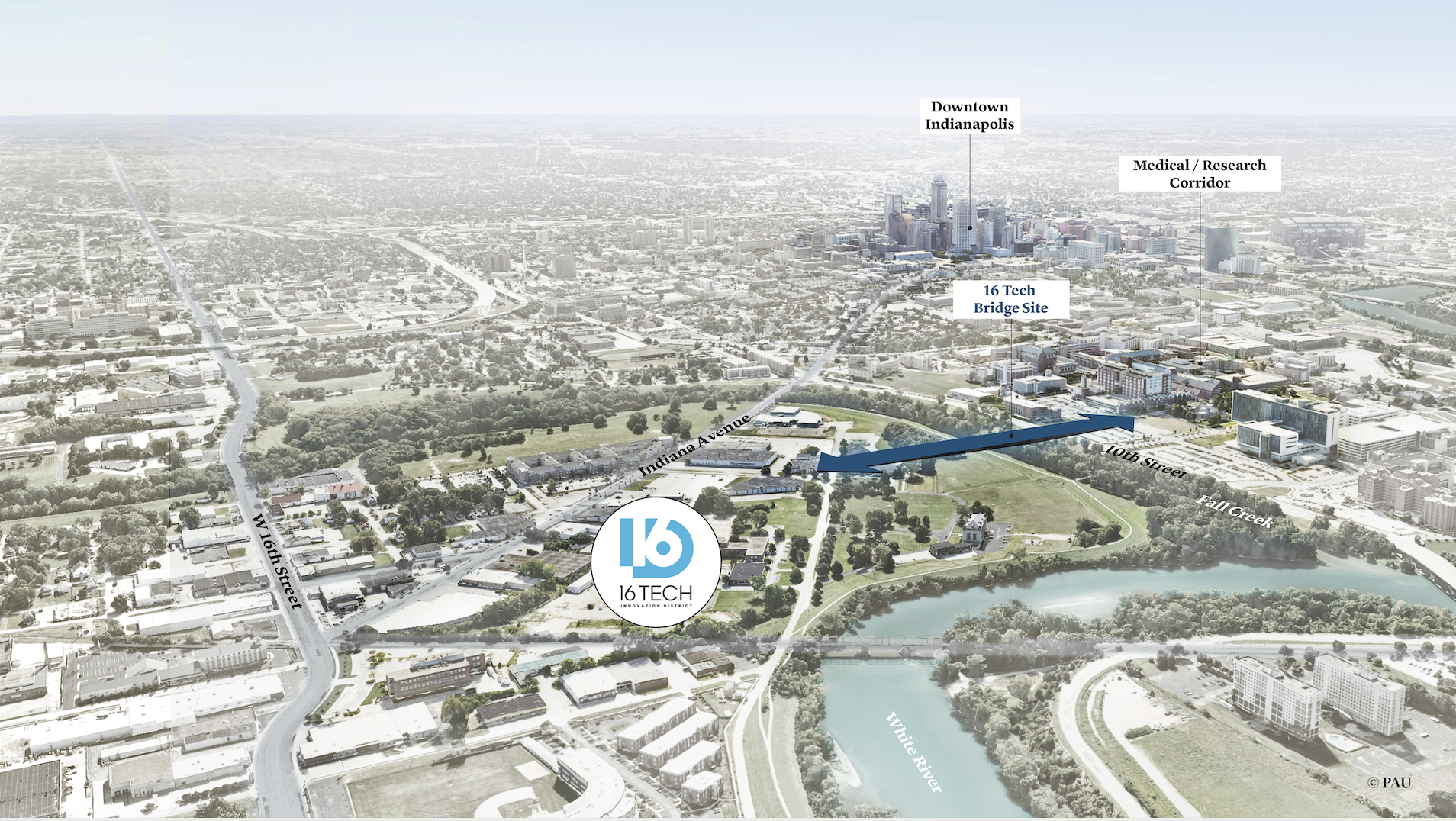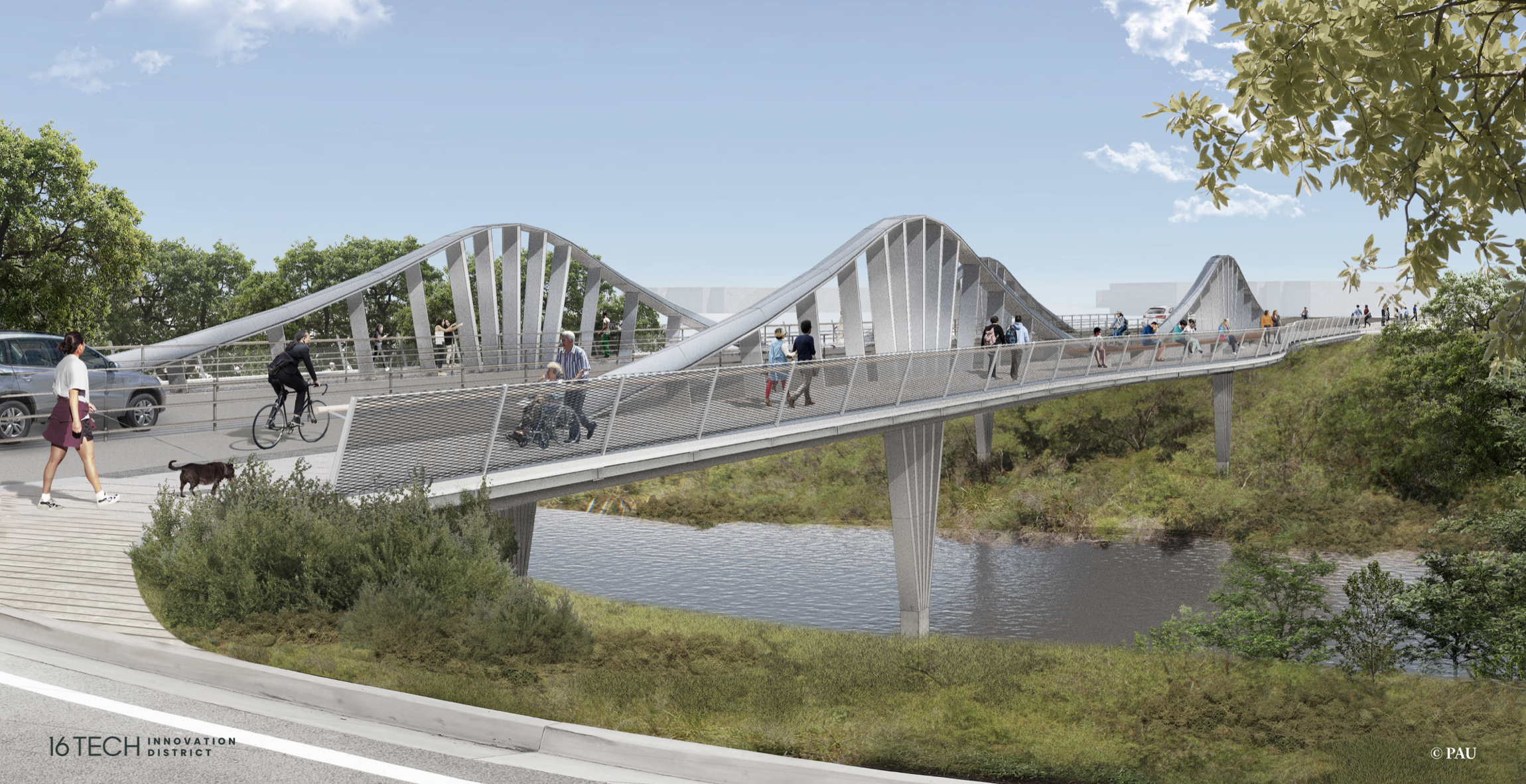INDIANAPOLIS – The 16 Tech Community Corporation revealed the design of a new signature bridge designed by a team led by schlaich bergermann partner (sbp) and Practice for Architecture and Urbanism (PAU). The bridge will span Fall Creek at West 10th Street and Riley Hospital Drive to connect the 16 Tech Innovation District to Indianapolis’ research/medical corridor and downtown.
The multi-disciplinary team of sbp, PAU, Moniteurs Communication Design, Martha Schwartz Partners (MSP), Shrewsberry & Associates, CTL Engineering, Circle Design Group and People for Urban Progress (PUP) were charged with designing a signature work of public infrastructure that will serve as an example of innovation and collaboration. In response, the team, which includes four Indianapolis firms, developed a structure that will be the first of its kind in the United States.
“The design team combined engineering, design thinking, and thoughtful community engagement to create a truly iconic and inclusive centerpiece for Indianapolis,” said Emily Krueger, Chief Operating Officer of 16 Tech Community Corporation and the project lead. “The 16 Tech bridge showcases the innovation at the heart of 16 Tech and continues to enhance the connectivity of our city.”
As part of the design process, the team spent six months engaging local residents, with a special focus the near West and near Northwest neighborhoods of Indianapolis, through mailers, online surveys, virtual meetings, a hotline in English and Spanish, site walks, neighborhood canvassing and a partnership with a local STEM-based school.
A local advisory committee of diverse Indianapolis residents and civic leaders helped shape the community engagement process, which informed the bridge design. In response to community feedback, the design team created a bridge with accessible public space, including dedicated space for bikes, pedestrians and respite, as well as a design that encourages connection to Fall Creek.
“This bridge is not only a significant piece of architecture, but a true representation of the collaborative spirit that has defined the 16 Tech project since its inception,” said Vop Osili, an architect and President of the Indianapolis City-County Council in whose district 16 Tech is located. “The voices of residents from the neighborhoods around 16 Tech were integral to the planning process, and the final design reflects that inclusive and forward-looking vision for our community.”
The bridge design prioritizes pedestrians and cyclists by creating protected pathways separated from vehicular traffic. With more than half of its square footage dedicated to non-vehicular use, the bridge will be unique in Indianapolis.
“Positioned at the nexus of Indianapolis’ trail network, the 16 Tech bridge will be the first in Marion County intentionally designed with a majority of its surface area dedicated to multi-modal users,” said Dan Parker, Director, Indianapolis Department of Public Works. “In addition to its place in our city’s infrastructure, it enhances the connections to the trails, parks and greenspaces that connect the neighborhoods in the near West and near Northwest.”
The bridge design also responds to the site’s unique natural conditions. One of the most striking features of Fall Creek is the seclusion created by the lines of trees on either side. Inspired by this, the bridge design creates tree-like vertical supports that mimic the trunk and branches of a tree. The bridge’s defining attribute, its undulating steel ribbon, mirrors the natural profile of Fall Creek. Its structure rises with the tree canopies on either side of the waterway and lowers towards the center to create unobstructed views up and down the creek. The bridge curves gently outwards on its Eastern edge, offering a cantilevered gathering space suspended over the water.
The signature wave-like form is the result of one of the bridge’s most significant and inventive features, its reinterpretation of the principles of a classic suspension bridge to create an entirely new form. This feat of engineering is accomplished by replacing the large vertical masts found on a typical suspension bridge with a fan-type arrangement of multiple smaller masts. Flat steel plates replace the traditional suspension cables as the main supports. The bridge’s tension element is allowed to follow the new mast arrangement. The resulting structure acts like a suspension bridge but is an entirely new approach to the genre. When built, this unique design will become the first of its kind in the United States.
The bridge will link the 16 Tech Innovation District and the city’s wider trail and greenway network, including the Indianapolis Cultural Trail. The design team will continue to refine the bridge design in the coming months and continue to engage local residents about the process. The bridge is targeted for completion by the end of 2023/early 2024.
Design and construction of the 16 Tech bridge are supported through funding from the City of Indianapolis and a $38 million grant from Lilly Endowment Inc. announced in March 2018, which helped fund the initial development of the 16 Tech Innovation District. In addition, Indiana University has donated land that supports the project.
“Lilly Endowment was inspired by the vision to connect the people and energy of the city’s research and medical innovation corridor with the emerging vibrancy of 16 Tech,” said Rob Smith, Lilly Endowment’s senior vice president for collaborative strategies. “We appreciate the creative, cooperative and inclusive process used to design this signature bridge and we look forward to its opening.”
JS Held LLC and American Structurepoint serve as advisors to 16 Tech through the design and construction of the bridge.
The public can learn more about the bridge design during 16 Tech’s community meeting on Friday, Dec. 17 at 9 a.m. Register here.
High-resolution images of the 16 Tech Bridge scheme are available here.
About the 16 Tech Bridge Design Team
In 2020, a committee of local and national experts in design, public transportation, urban planning, and landscape architecture guided an international RFQ/P process to select the design team. More than half of the firms on the design team are minority business enterprises (MBE), women-owned businesses or women business enterprises (WBE). The firms are:
- schlaich bergermann partner (sbp), New York
- Practice for Architecture and Urbanism (PAU), New York (MBE)
- Moniteurs Communication Design, Berlin, Germany (woman-owned business)
- Martha Schwartz Partners, New York (WBE)
- Shrewsberry & Associates, Indianapolis (MBE)
- CTL Engineering, Indianapolis (MBE)
- Circle Design Group, Indianapolis
- People for Urban Progress (PUP), Indianapolis (woman-led organization)
In addition to encouraging diversity within its design team, 16 Tech Community Corporation is committed to achieving the City of Indianapolis XBE and workforce utilization goals for the construction of the bridge. Parties interested in performing work in the construction of the bridge and associated roads may sign up for information at 16tech.com/develop/bidding-opportunities.
About 16 Tech
The 16 Tech Innovation District is a 50-acre community dedicated to world-changing innovation and economic opportunity. Located in the historic Riverside neighborhood of Indianapolis, 16 Tech leverages its proximity to top academic, corporate, and healthcare institutions—and a growing network of spaces, programs, and talent—to foster the cross-industry convergence and collaboration that make world-changing innovation possible. The nonprofit 16 Tech Community Corporation oversees the development of the district and ensures benefits of economic growth, new investment and job creation extend to nearby neighborhoods as well as the city, the region, and the state. More information can be found at www.16tech.com.
About sbp
schlaich bergermann partner (sbp) is an international, award-winning structural engineering design firm founded in Stuttgart, Germany in 1980 with offices in New York, Berlin, Shanghai, Paris, São Paulo, and Madrid. They design celebrated bridges, long-span lightweight roofs, slender towers, and innovative buildings across the world. sbp pursues the philosophy of Baukultur, the culture of building and the building of culture, for all of their bridge projects. This involves a thoughtful approach to finding efficient, elegant, and environmentally sensitive design solutions that respond uniquely to their site and context. sbp works with clients, collaborators, and the public to create bridges that provide both a connection to communities and a cherished symbol of regional transformation. www.sbp.de
About Practice for Architecture and Urbanism
PAU is a multi-disciplinary design and planning firm leading some of the most complex projects in the country and, increasingly, around the world. The studio designs lasting architecture and humanist urbanism to advance the city of the future, to advance the values of liberté, égalité, et humanité that undergird metropolitan life. PAU takes on this mission informed by decades of proven experience, guided by the ideal that by reinventing cities, it can help shepherd the world to betterment, self-reflection, and public delight. Visit PAU at https://pau.studio.
# # #
Media Contact:
Jacqueline Cromleigh Eckhardt
Director of Communications, 16 Tech
jeckhardt@16tech.com | 614.390.9210



